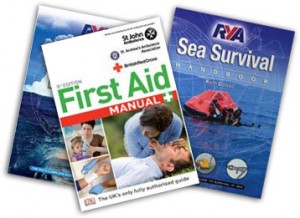 I once attended a first aid course in the south of England, and as part of the course we covered sunstroke. In the north of England they cover hypothermia.
I once attended a first aid course in the south of England, and as part of the course we covered sunstroke. In the north of England they cover hypothermia.
Which underlines the fact that a first aid course is only as good as the circumstances in which you are likely to find yourself needing to carry out first aid. In other words, if you’re heading out sailing, having a sailing first aid course under your belt is not just sensible, it’s essential. So what are your options?
The Royal Yachting Association runs a first aid course which lasts one day, and which is enough to cover the needs of a professional skipper in a small boat who is within sixty miles of a safe haven. This is usually more than enough for those who are looking at sailing around a few islands in the Mediterranean. So what’s covered?
Clearly when at sea there are completely different challenges and risks than you would be likely to come across on land. But more than this perhaps is the fact that when you are at sea you can’t just phone for an ambulance, or stuff your friend or family member into the boot of your car and leg it down to the local A & E.
When at sea, any emergency is exactly that, and it needs immediate treatment. It needs the right treatment, done the right way at the right time. Lives are at stake, and knowing what to do is vital. Being able to remain calm is critical, and having completed an RYA first aid course you’ll be more likely to remain calm because you’ll be confident you know what to do in an emergency situation.
Whilst there are several things covered by the course which you’ll find covered in ordinary land based courses, there are often unique challenges facing you when trying to carry these out whilst at sea. So, for example, you will learn how to put someone in a recovery position, just as you would normally on any other first aid course. But with this RYA course you will also learn how to do this effectively and safely in a confined space.
You will learn CPR, but you will also be taught the additional drowning protocol which is not normally included as part of a standard first aid course. Clearly drowning is a potential risk at sea, and it will be vital to know not just how to carry out CPR or put someone in the recovery position, but how to adapt that approach in a way which is safe and effective.
Other topics included range from cold shock and hypothermia (the latter being especially useful if you’re visiting the North Coast!), as well as seasickness, and dehydration (not personally a risk thanks to the Dog & Duck).
There are less obvious things included in the course too, such as how to obtain medical assistance or medical advice using a VHF transceiver, as well as the protocols and methods of obtaining help via helicopter.
The course really is quite extensive, and is essential for anyone heading out to sea, whether in calm, blue, still waters or more challenging open seas. The RYA first aid course for sailing fulfils all of the requirements for the Senior First Aid certificate which is required by offshore racers, and for skippers working small craft 60 miles out to sea. I strongly recommend it, not just for the skipper of course, because if the skipper needs medical attention any of the crew need to be trained properly too.